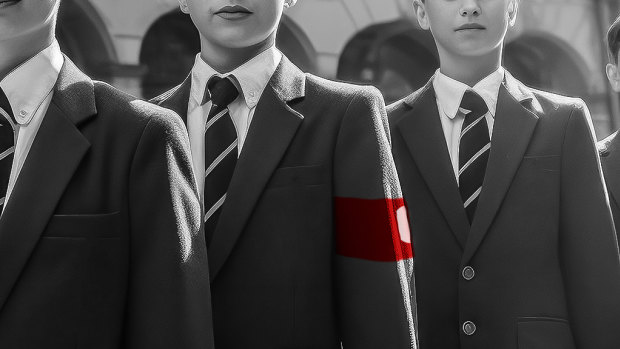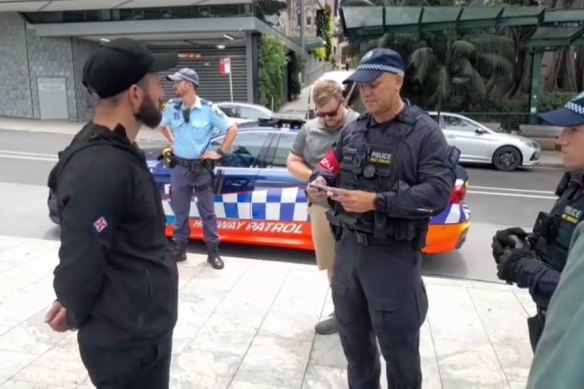- Exclusive
- National
- Right-wing extremism
This was published 1 year ago
Swastikas, schoolboys and social media: teachers face growing problem
By Jordan Baker
At a public, inner west high school, a year 7 student gave the Sieg Heil salute to taunt a classmate. In a high-fee eastern suburbs boys’ school, a boy in full uniform at school was videoed performing the Nazi salute. At another nearby, swastikas were drawn on younger students’ hands.
In Sydney’s north, students at Knox Grammar praised Adolf Hitler in a social media chat group.
They’re not isolated incidents. School counsellors, teachers and social media experts say the invocation of Nazi symbols and speech is a simmering problem in schools, mostly among teenage boys who are daring each other towards ever-more anti-social behaviour.

One in four teachers said they had experienced, witnessed or been told of antisemitic incidents.Credit: Matthew Absalom-Wong
Their views are backed by new research from Liberal-aligned think tank the Blueprint Institute, which surveyed more than 500 teachers at Australian public schools and found one in four had experienced, witnessed or been told of antisemitic incidents.
More than half – 57 per cent – reported the incidents involved the use of Nazi symbols or otherwise invoked Hitler’s Germany and the Holocaust. Others involved slurs about appearance, or antisemitic tropes. The problem is more common in high schools.
The vast majority of these students are not becoming radicalised by this culture. Neo-Nazi numbers remain small; of the balaclava-clad group detailed by police in Sydney on Australia Day, only 27 were from NSW.
“It’s more about the daring,” said one school counsellor, speaking anonymously because they were not permitted to talk to journalists. “It’s about the risk factor; a game of chicken, not unlike testing how far they can hang off the back of a train.
“They know it’s a big deal, but they don’t really understand what it means. They feel like they need to be involved because everyone else is.”
As one teacher in the Blueprint survey pointed out, “there are some rare instances of students, overwhelmingly male, who will make use of gestures and phrases related to Nazis, always from a place of ignorance, who stop when the significance is explained to them.”
The underlying problem, says Safe on Social chief executive Kirra Pendergast, is unfettered use of social media by children who are being bombarded with information they don’t understand, and an age-old teenage predilection to follow the herd.
Particularly since the Hamas attacks on Israel last October, social media sites popular with teens have been flooded with racist and misleading information, Pendergast said. “They might see someone doing the Hitler salute, and think that looks cool,” she said.
“Parents haven’t taught the child [about the Holocaust] because the child is not old enough, but the child is being exposed to it.
“We’ve got a whole generation of parents saying, ‘I’m going to isolate my kids if I don’t get them a device’. They’re not thinking about what that child is being exposed to online. We need to take a good hard look at ourselves, and teach right and wrong and ethics … before we hand our children devices.”
Neo-Nazi groups recruit from online chat groups by singling out people who show an openness to their views. Their leaders are young, too; the most high-profile, Thomas Sewell, is barely 30 and two others, Jack Eltis and Jacob Hersant, are in their mid-20s.

A NSW police officer serves Thomas Sewell (left) with an order prohibiting him from entering the City of Sydney on Australia Day.
The Blueprint report also raised concerns about the influence of social media, and the algorithms that quickly normalise anti-social behaviour by following up a teen’s curious click on a taboo post by serving up similar content.
“Contributing to this risk is the existence of cloaked or coded forms of antisemitism, some of which may use humour to reinforce hurtful and derogatory stereotypes,” it said.
Blueprint’s chief executive Liana Downey said education departments have proactively addressed radicalisation by identifying young people at risk and ensuring they feel more connected to their school and community.
“Given the prevalence of antisemitism in schools as shown by our poll, as well as the dramatic rise in overt and covert forms of antisemitism more broadly, there is a clear need for governments to deploy these approaches more broadly,” she said.
David Ossip, the president of the NSW Jewish Board of Deputies, described the figures in the report as disturbing and said they revealed a sinister undercurrent of hate.
“Parents and schools need to be critically aware of the role that smartphones and social media play in desensitising young and formative minds to antisemitic tropes and Nazi symbols,” he said.
“The success of our cohesive, multicultural society is dependent on stamping out such manifestations of hate. Clearly, this includes holding social media companies responsible for the content on their platforms and educating the next generation about the evil of Nazism and why a generation of Australian servicemen and women fought against it.
“Intolerance against one group, if left unchecked, can very quickly mutate to animosity against other groups and tear at the seams of what binds us together.”
Start the day with a summary of the day’s most important and interesting stories, analysis and insights. Sign up for our Morning Edition newsletter.